Food Safety: Preventing Contamination and Food Spoilage Report
VerifiedAdded on 2020/11/23
|20
|7392
|182
Report
AI Summary
This report provides a comprehensive overview of food safety management, encompassing critical aspects such as contamination prevention, food spoilage agents, and effective preservation methods. It begins by examining controls required to prevent physical and chemical contamination, comparing the characteristics of food poisoning and foodborne infections, and detailing strategies for controlling foodborne illnesses. The report then categorizes food spoilage agents, explores various food preservation techniques, and evaluates their effectiveness. Further, it discusses key steps in temperature control systems, summarizes methods for safe food storage, and emphasizes the importance of personal hygiene in preventing food contamination. The report concludes by synthesizing the key findings and highlighting the significance of adhering to food safety protocols to ensure the provision of safe and healthy food products. The report emphasizes the importance of training, HACCP plans and maintaining proper hygiene.
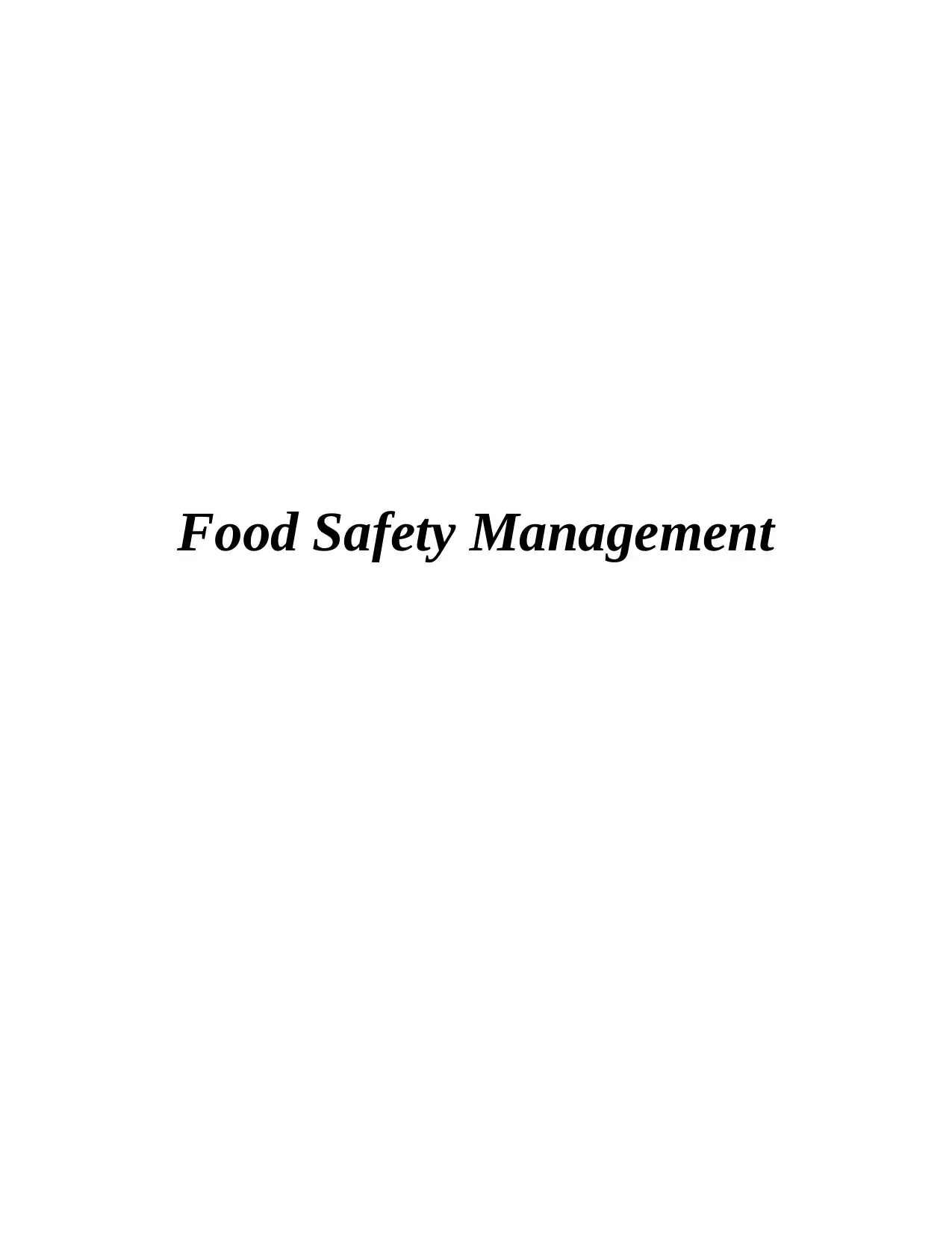
Food Safety Management
Paraphrase This Document
Need a fresh take? Get an instant paraphrase of this document with our AI Paraphraser
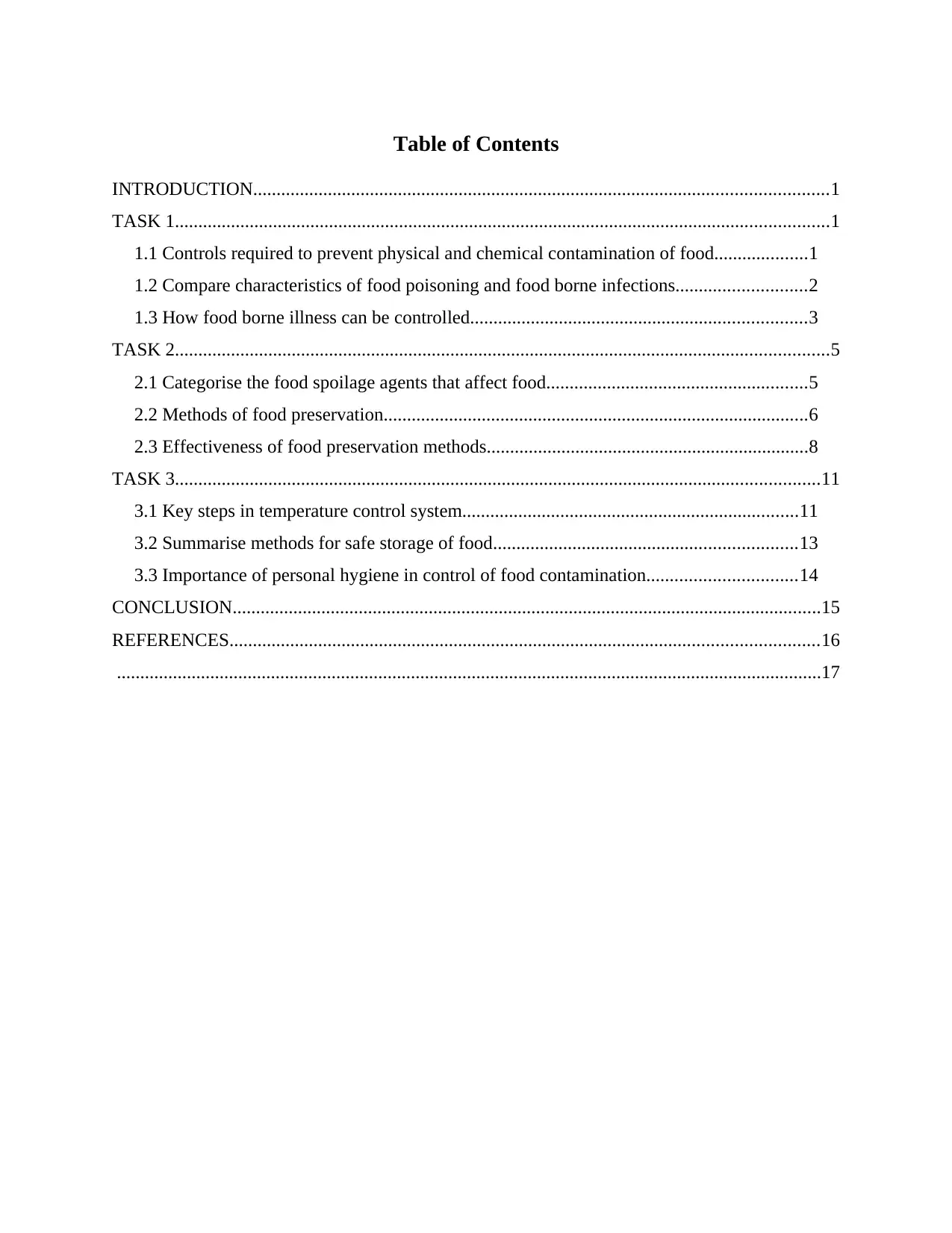
Table of Contents
INTRODUCTION...........................................................................................................................1
TASK 1............................................................................................................................................1
1.1 Controls required to prevent physical and chemical contamination of food....................1
1.2 Compare characteristics of food poisoning and food borne infections............................2
1.3 How food borne illness can be controlled........................................................................3
TASK 2............................................................................................................................................5
2.1 Categorise the food spoilage agents that affect food........................................................5
2.2 Methods of food preservation...........................................................................................6
2.3 Effectiveness of food preservation methods.....................................................................8
TASK 3..........................................................................................................................................11
3.1 Key steps in temperature control system........................................................................11
3.2 Summarise methods for safe storage of food.................................................................13
3.3 Importance of personal hygiene in control of food contamination................................14
CONCLUSION..............................................................................................................................15
REFERENCES..............................................................................................................................16
.......................................................................................................................................................17
INTRODUCTION...........................................................................................................................1
TASK 1............................................................................................................................................1
1.1 Controls required to prevent physical and chemical contamination of food....................1
1.2 Compare characteristics of food poisoning and food borne infections............................2
1.3 How food borne illness can be controlled........................................................................3
TASK 2............................................................................................................................................5
2.1 Categorise the food spoilage agents that affect food........................................................5
2.2 Methods of food preservation...........................................................................................6
2.3 Effectiveness of food preservation methods.....................................................................8
TASK 3..........................................................................................................................................11
3.1 Key steps in temperature control system........................................................................11
3.2 Summarise methods for safe storage of food.................................................................13
3.3 Importance of personal hygiene in control of food contamination................................14
CONCLUSION..............................................................................................................................15
REFERENCES..............................................................................................................................16
.......................................................................................................................................................17

⊘ This is a preview!⊘
Do you want full access?
Subscribe today to unlock all pages.

Trusted by 1+ million students worldwide
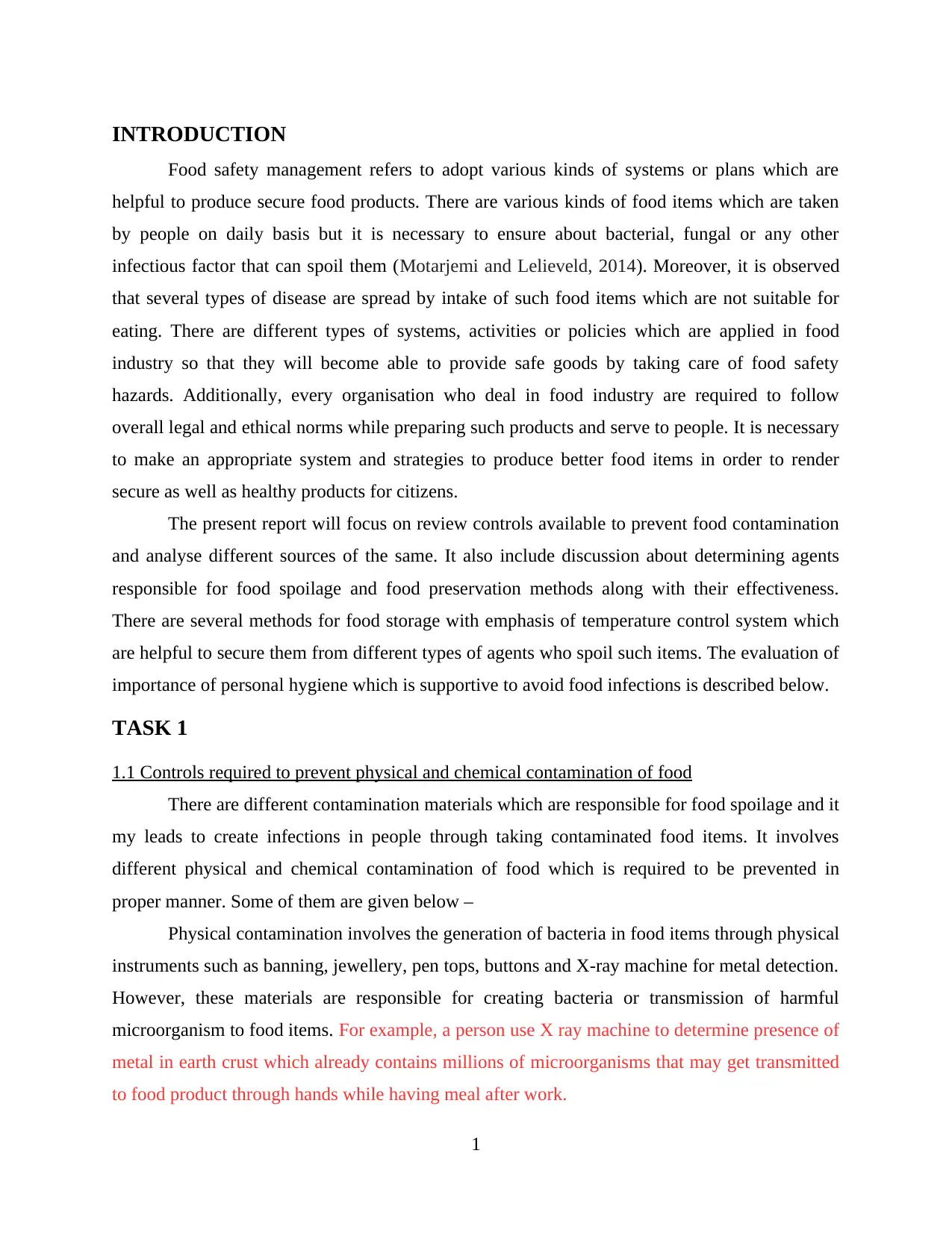
INTRODUCTION
Food safety management refers to adopt various kinds of systems or plans which are
helpful to produce secure food products. There are various kinds of food items which are taken
by people on daily basis but it is necessary to ensure about bacterial, fungal or any other
infectious factor that can spoil them (Motarjemi and Lelieveld, 2014). Moreover, it is observed
that several types of disease are spread by intake of such food items which are not suitable for
eating. There are different types of systems, activities or policies which are applied in food
industry so that they will become able to provide safe goods by taking care of food safety
hazards. Additionally, every organisation who deal in food industry are required to follow
overall legal and ethical norms while preparing such products and serve to people. It is necessary
to make an appropriate system and strategies to produce better food items in order to render
secure as well as healthy products for citizens.
The present report will focus on review controls available to prevent food contamination
and analyse different sources of the same. It also include discussion about determining agents
responsible for food spoilage and food preservation methods along with their effectiveness.
There are several methods for food storage with emphasis of temperature control system which
are helpful to secure them from different types of agents who spoil such items. The evaluation of
importance of personal hygiene which is supportive to avoid food infections is described below.
TASK 1
1.1 Controls required to prevent physical and chemical contamination of food
There are different contamination materials which are responsible for food spoilage and it
my leads to create infections in people through taking contaminated food items. It involves
different physical and chemical contamination of food which is required to be prevented in
proper manner. Some of them are given below –
Physical contamination involves the generation of bacteria in food items through physical
instruments such as banning, jewellery, pen tops, buttons and X-ray machine for metal detection.
However, these materials are responsible for creating bacteria or transmission of harmful
microorganism to food items. For example, a person use X ray machine to determine presence of
metal in earth crust which already contains millions of microorganisms that may get transmitted
to food product through hands while having meal after work.
1
Food safety management refers to adopt various kinds of systems or plans which are
helpful to produce secure food products. There are various kinds of food items which are taken
by people on daily basis but it is necessary to ensure about bacterial, fungal or any other
infectious factor that can spoil them (Motarjemi and Lelieveld, 2014). Moreover, it is observed
that several types of disease are spread by intake of such food items which are not suitable for
eating. There are different types of systems, activities or policies which are applied in food
industry so that they will become able to provide safe goods by taking care of food safety
hazards. Additionally, every organisation who deal in food industry are required to follow
overall legal and ethical norms while preparing such products and serve to people. It is necessary
to make an appropriate system and strategies to produce better food items in order to render
secure as well as healthy products for citizens.
The present report will focus on review controls available to prevent food contamination
and analyse different sources of the same. It also include discussion about determining agents
responsible for food spoilage and food preservation methods along with their effectiveness.
There are several methods for food storage with emphasis of temperature control system which
are helpful to secure them from different types of agents who spoil such items. The evaluation of
importance of personal hygiene which is supportive to avoid food infections is described below.
TASK 1
1.1 Controls required to prevent physical and chemical contamination of food
There are different contamination materials which are responsible for food spoilage and it
my leads to create infections in people through taking contaminated food items. It involves
different physical and chemical contamination of food which is required to be prevented in
proper manner. Some of them are given below –
Physical contamination involves the generation of bacteria in food items through physical
instruments such as banning, jewellery, pen tops, buttons and X-ray machine for metal detection.
However, these materials are responsible for creating bacteria or transmission of harmful
microorganism to food items. For example, a person use X ray machine to determine presence of
metal in earth crust which already contains millions of microorganisms that may get transmitted
to food product through hands while having meal after work.
1
Paraphrase This Document
Need a fresh take? Get an instant paraphrase of this document with our AI Paraphraser
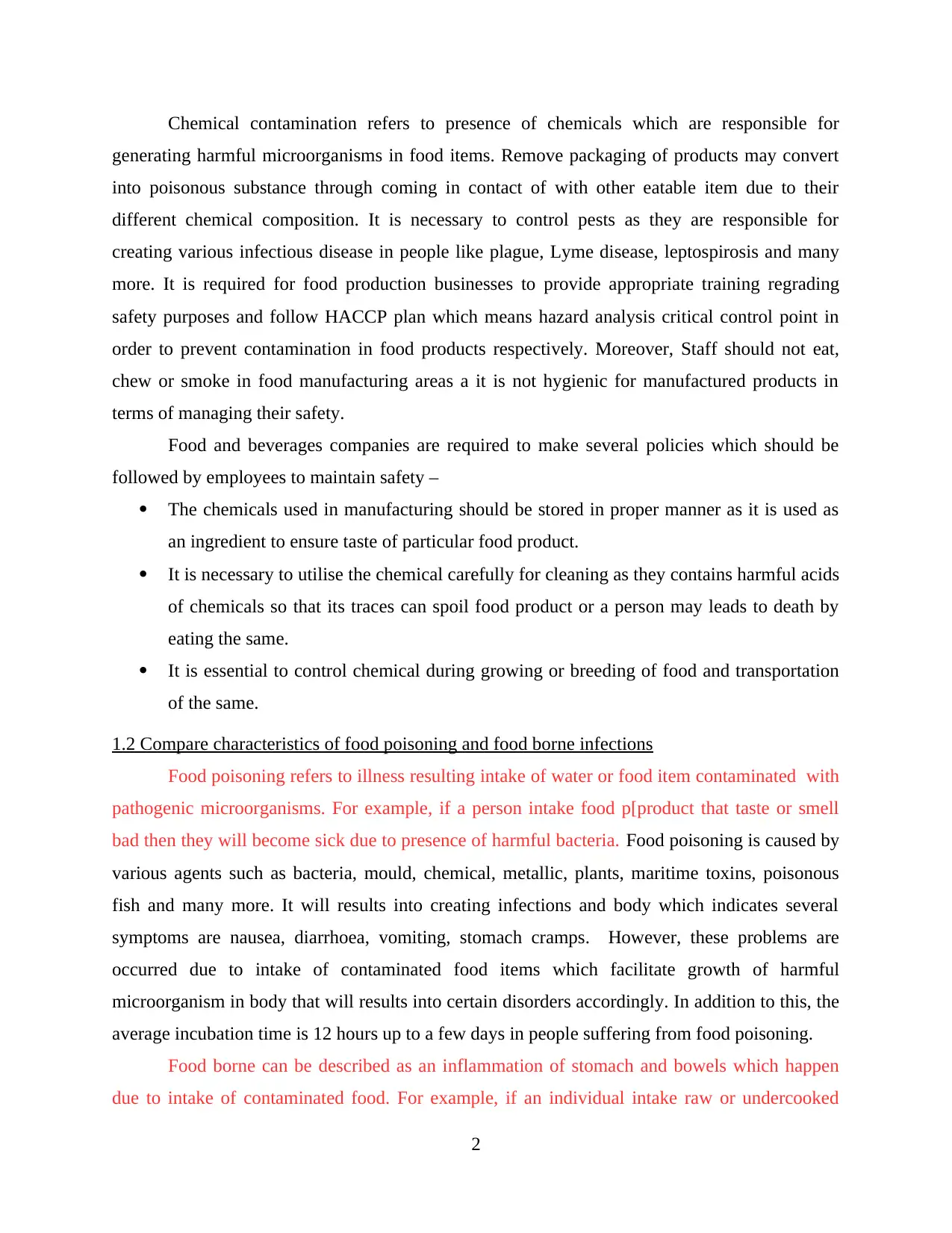
Chemical contamination refers to presence of chemicals which are responsible for
generating harmful microorganisms in food items. Remove packaging of products may convert
into poisonous substance through coming in contact of with other eatable item due to their
different chemical composition. It is necessary to control pests as they are responsible for
creating various infectious disease in people like plague, Lyme disease, leptospirosis and many
more. It is required for food production businesses to provide appropriate training regrading
safety purposes and follow HACCP plan which means hazard analysis critical control point in
order to prevent contamination in food products respectively. Moreover, Staff should not eat,
chew or smoke in food manufacturing areas a it is not hygienic for manufactured products in
terms of managing their safety.
Food and beverages companies are required to make several policies which should be
followed by employees to maintain safety –
The chemicals used in manufacturing should be stored in proper manner as it is used as
an ingredient to ensure taste of particular food product.
It is necessary to utilise the chemical carefully for cleaning as they contains harmful acids
of chemicals so that its traces can spoil food product or a person may leads to death by
eating the same.
It is essential to control chemical during growing or breeding of food and transportation
of the same.
1.2 Compare characteristics of food poisoning and food borne infections
Food poisoning refers to illness resulting intake of water or food item contaminated with
pathogenic microorganisms. For example, if a person intake food p[product that taste or smell
bad then they will become sick due to presence of harmful bacteria. Food poisoning is caused by
various agents such as bacteria, mould, chemical, metallic, plants, maritime toxins, poisonous
fish and many more. It will results into creating infections and body which indicates several
symptoms are nausea, diarrhoea, vomiting, stomach cramps. However, these problems are
occurred due to intake of contaminated food items which facilitate growth of harmful
microorganism in body that will results into certain disorders accordingly. In addition to this, the
average incubation time is 12 hours up to a few days in people suffering from food poisoning.
Food borne can be described as an inflammation of stomach and bowels which happen
due to intake of contaminated food. For example, if an individual intake raw or undercooked
2
generating harmful microorganisms in food items. Remove packaging of products may convert
into poisonous substance through coming in contact of with other eatable item due to their
different chemical composition. It is necessary to control pests as they are responsible for
creating various infectious disease in people like plague, Lyme disease, leptospirosis and many
more. It is required for food production businesses to provide appropriate training regrading
safety purposes and follow HACCP plan which means hazard analysis critical control point in
order to prevent contamination in food products respectively. Moreover, Staff should not eat,
chew or smoke in food manufacturing areas a it is not hygienic for manufactured products in
terms of managing their safety.
Food and beverages companies are required to make several policies which should be
followed by employees to maintain safety –
The chemicals used in manufacturing should be stored in proper manner as it is used as
an ingredient to ensure taste of particular food product.
It is necessary to utilise the chemical carefully for cleaning as they contains harmful acids
of chemicals so that its traces can spoil food product or a person may leads to death by
eating the same.
It is essential to control chemical during growing or breeding of food and transportation
of the same.
1.2 Compare characteristics of food poisoning and food borne infections
Food poisoning refers to illness resulting intake of water or food item contaminated with
pathogenic microorganisms. For example, if a person intake food p[product that taste or smell
bad then they will become sick due to presence of harmful bacteria. Food poisoning is caused by
various agents such as bacteria, mould, chemical, metallic, plants, maritime toxins, poisonous
fish and many more. It will results into creating infections and body which indicates several
symptoms are nausea, diarrhoea, vomiting, stomach cramps. However, these problems are
occurred due to intake of contaminated food items which facilitate growth of harmful
microorganism in body that will results into certain disorders accordingly. In addition to this, the
average incubation time is 12 hours up to a few days in people suffering from food poisoning.
Food borne can be described as an inflammation of stomach and bowels which happen
due to intake of contaminated food. For example, if an individual intake raw or undercooked
2

meat then it will create food borne infection. Food borne infection occurs when people intake
food which looks, smell & taste normal and it is actually contains ingested pathogens and these
generate illness accordingly. It is usually caused by several agents including bacteria, viruses and
parasites which generate poisonous elements in food items that can make an individual.
However, it can be identified by certain symptoms which re similar to the indications of food
poisoning along with creating health problems like liver, kidney, heart, brain disease and death
is a possible outcome. Additionally, the incubation time is measured in food borne infections is
from 24 hours up to days, weeks, month or years.
1.3 How food borne illness can be controlled
Food borne illness can be controlled by intake safe and bacteria free food items through
maintaining personal hygiene and cleanliness in surroundings. The food items are basic need of
human being it is required to be made by taking care of proper cleanliness while preparing the
same. It involves to follow several effective as well as efficient methods in order to prevent
contamination from eatable products. Moreover, cleanliness is very important factor while
prepare or intake them because may of severe disease can be generate through eating spoiled
food (Kirezieva, Luning and Jacxsens, 2015). Many times, it is analysed that people do not wash
their hands before and after eating which is very infectious for their health and create health
issue. However, there are various kinds of practices or techniques which are required to be
utilised by manufacturer and user of food items to maintain cleanliness of food products
products. Additionally, it is necessary to apply methods of preventing contamination of food
items in which few of them are explained further –
Keep clean – This can be described to remain clean while going to cook and serve food
as well as prefer to wash hands, dishcloths and cook tops properly on regular basis. It is
necessary to maintain proper hygiene in order to avoid entry of bacteria or fungi in any of food
products or relevant raw material (Tenenhaus‐Aziza, Daudin and Maffre, 2014). It is necessary
to to wash hands while handling raw food such as meat, fish, eggs and vegetables which is
helpful to prevent food contamination properly. Moreover, cooks or chefs should be instructed
strictly in hotels or restaurants for taking care of hygiene because it is major fact which is
responsible for food poisoning. Additionally, it is required to put efforts to avoid harmful
chemicals from kitchen area by taking them apart from the same.
3
food which looks, smell & taste normal and it is actually contains ingested pathogens and these
generate illness accordingly. It is usually caused by several agents including bacteria, viruses and
parasites which generate poisonous elements in food items that can make an individual.
However, it can be identified by certain symptoms which re similar to the indications of food
poisoning along with creating health problems like liver, kidney, heart, brain disease and death
is a possible outcome. Additionally, the incubation time is measured in food borne infections is
from 24 hours up to days, weeks, month or years.
1.3 How food borne illness can be controlled
Food borne illness can be controlled by intake safe and bacteria free food items through
maintaining personal hygiene and cleanliness in surroundings. The food items are basic need of
human being it is required to be made by taking care of proper cleanliness while preparing the
same. It involves to follow several effective as well as efficient methods in order to prevent
contamination from eatable products. Moreover, cleanliness is very important factor while
prepare or intake them because may of severe disease can be generate through eating spoiled
food (Kirezieva, Luning and Jacxsens, 2015). Many times, it is analysed that people do not wash
their hands before and after eating which is very infectious for their health and create health
issue. However, there are various kinds of practices or techniques which are required to be
utilised by manufacturer and user of food items to maintain cleanliness of food products
products. Additionally, it is necessary to apply methods of preventing contamination of food
items in which few of them are explained further –
Keep clean – This can be described to remain clean while going to cook and serve food
as well as prefer to wash hands, dishcloths and cook tops properly on regular basis. It is
necessary to maintain proper hygiene in order to avoid entry of bacteria or fungi in any of food
products or relevant raw material (Tenenhaus‐Aziza, Daudin and Maffre, 2014). It is necessary
to to wash hands while handling raw food such as meat, fish, eggs and vegetables which is
helpful to prevent food contamination properly. Moreover, cooks or chefs should be instructed
strictly in hotels or restaurants for taking care of hygiene because it is major fact which is
responsible for food poisoning. Additionally, it is required to put efforts to avoid harmful
chemicals from kitchen area by taking them apart from the same.
3
⊘ This is a preview!⊘
Do you want full access?
Subscribe today to unlock all pages.

Trusted by 1+ million students worldwide
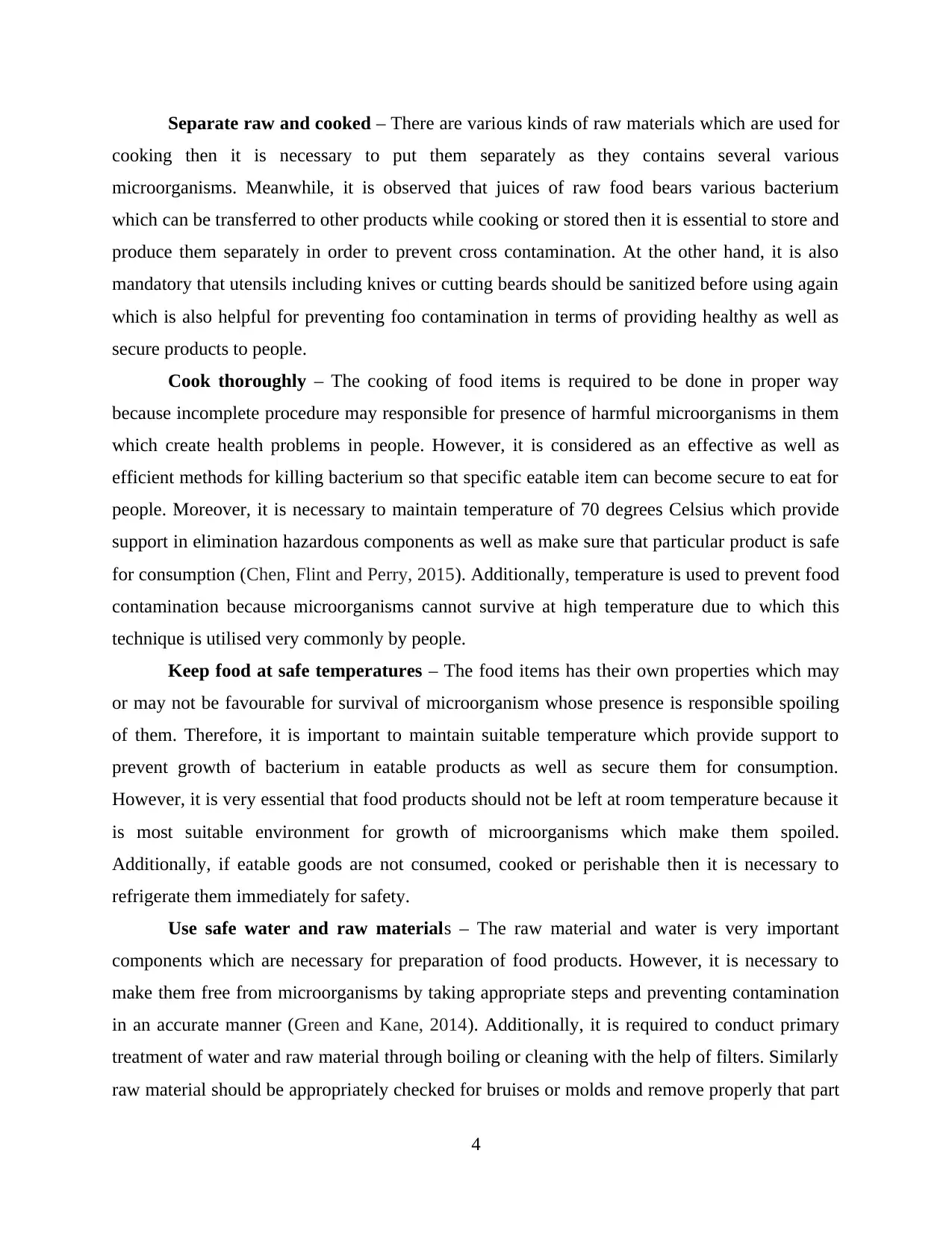
Separate raw and cooked – There are various kinds of raw materials which are used for
cooking then it is necessary to put them separately as they contains several various
microorganisms. Meanwhile, it is observed that juices of raw food bears various bacterium
which can be transferred to other products while cooking or stored then it is essential to store and
produce them separately in order to prevent cross contamination. At the other hand, it is also
mandatory that utensils including knives or cutting beards should be sanitized before using again
which is also helpful for preventing foo contamination in terms of providing healthy as well as
secure products to people.
Cook thoroughly – The cooking of food items is required to be done in proper way
because incomplete procedure may responsible for presence of harmful microorganisms in them
which create health problems in people. However, it is considered as an effective as well as
efficient methods for killing bacterium so that specific eatable item can become secure to eat for
people. Moreover, it is necessary to maintain temperature of 70 degrees Celsius which provide
support in elimination hazardous components as well as make sure that particular product is safe
for consumption (Chen, Flint and Perry, 2015). Additionally, temperature is used to prevent food
contamination because microorganisms cannot survive at high temperature due to which this
technique is utilised very commonly by people.
Keep food at safe temperatures – The food items has their own properties which may
or may not be favourable for survival of microorganism whose presence is responsible spoiling
of them. Therefore, it is important to maintain suitable temperature which provide support to
prevent growth of bacterium in eatable products as well as secure them for consumption.
However, it is very essential that food products should not be left at room temperature because it
is most suitable environment for growth of microorganisms which make them spoiled.
Additionally, if eatable goods are not consumed, cooked or perishable then it is necessary to
refrigerate them immediately for safety.
Use safe water and raw materials – The raw material and water is very important
components which are necessary for preparation of food products. However, it is necessary to
make them free from microorganisms by taking appropriate steps and preventing contamination
in an accurate manner (Green and Kane, 2014). Additionally, it is required to conduct primary
treatment of water and raw material through boiling or cleaning with the help of filters. Similarly
raw material should be appropriately checked for bruises or molds and remove properly that part
4
cooking then it is necessary to put them separately as they contains several various
microorganisms. Meanwhile, it is observed that juices of raw food bears various bacterium
which can be transferred to other products while cooking or stored then it is essential to store and
produce them separately in order to prevent cross contamination. At the other hand, it is also
mandatory that utensils including knives or cutting beards should be sanitized before using again
which is also helpful for preventing foo contamination in terms of providing healthy as well as
secure products to people.
Cook thoroughly – The cooking of food items is required to be done in proper way
because incomplete procedure may responsible for presence of harmful microorganisms in them
which create health problems in people. However, it is considered as an effective as well as
efficient methods for killing bacterium so that specific eatable item can become secure to eat for
people. Moreover, it is necessary to maintain temperature of 70 degrees Celsius which provide
support in elimination hazardous components as well as make sure that particular product is safe
for consumption (Chen, Flint and Perry, 2015). Additionally, temperature is used to prevent food
contamination because microorganisms cannot survive at high temperature due to which this
technique is utilised very commonly by people.
Keep food at safe temperatures – The food items has their own properties which may
or may not be favourable for survival of microorganism whose presence is responsible spoiling
of them. Therefore, it is important to maintain suitable temperature which provide support to
prevent growth of bacterium in eatable products as well as secure them for consumption.
However, it is very essential that food products should not be left at room temperature because it
is most suitable environment for growth of microorganisms which make them spoiled.
Additionally, if eatable goods are not consumed, cooked or perishable then it is necessary to
refrigerate them immediately for safety.
Use safe water and raw materials – The raw material and water is very important
components which are necessary for preparation of food products. However, it is necessary to
make them free from microorganisms by taking appropriate steps and preventing contamination
in an accurate manner (Green and Kane, 2014). Additionally, it is required to conduct primary
treatment of water and raw material through boiling or cleaning with the help of filters. Similarly
raw material should be appropriately checked for bruises or molds and remove properly that part
4
Paraphrase This Document
Need a fresh take? Get an instant paraphrase of this document with our AI Paraphraser

from them immediately to prevent contamination. Furthermore, expired food items are required
to be thrown away because it can contribute to health risks for overall family members.
Training – The training should be provided to employees working in food industry to
make them aware of using proper ingredients and material in order to prevent food borne
infection. It is essential to make people capable to determine suitable material for using to make
food product.
HACCP plans – This can be described as a systematic approach to determine, evaluation
and control of food safety hazards by considering several principles in order to prevent food
borne infections. However, it include to conduct hazard analysis and identifying critical control
points along with establishing critical control limits. Moreover, establish monitoring procedures,
verification procedures, record keeping and documentation activities.
At last but not the least, prevention of food contamination is not much difficult task but it
can be easily carried out thorough remaining alert as well as conscious of harmful components.
Meanwhile, it is necessary to ensure safety while handling eatable products and put efforts to
make them suitable for consumption along with preventing harmful microorganisms from them.
Furthermore, it provide support to intake secure and healthy food which helps to increase
efficiency of immune system of human body to fight with different health issues.
TASK 2
2.1 Categorise the food spoilage agents that affect food
The agents of food spoilage refers to those factors which are responsible for spoiling of
food items by facilitating growth of microorganisms like bacteria, fungi etc. It include several
agents which are required to be prevented from touching eatable products in order to make them
suitable for intake (Unnevehr and Hoffmann, 2015). There are various kinds of factors which are
considered as potential agents for food spoilage and some of them are as follows –
Bacteria – There are various kinds of bacterium which are unicellular organisms in very
small size and they will asexually reproduce so that increase in population of them may cause
human illness and food spoilage. Moreover, the entry of pathogenic bacteria into eatable items
may cause food to be rotten and intake of such substances results into sickness in human being.
5
to be thrown away because it can contribute to health risks for overall family members.
Training – The training should be provided to employees working in food industry to
make them aware of using proper ingredients and material in order to prevent food borne
infection. It is essential to make people capable to determine suitable material for using to make
food product.
HACCP plans – This can be described as a systematic approach to determine, evaluation
and control of food safety hazards by considering several principles in order to prevent food
borne infections. However, it include to conduct hazard analysis and identifying critical control
points along with establishing critical control limits. Moreover, establish monitoring procedures,
verification procedures, record keeping and documentation activities.
At last but not the least, prevention of food contamination is not much difficult task but it
can be easily carried out thorough remaining alert as well as conscious of harmful components.
Meanwhile, it is necessary to ensure safety while handling eatable products and put efforts to
make them suitable for consumption along with preventing harmful microorganisms from them.
Furthermore, it provide support to intake secure and healthy food which helps to increase
efficiency of immune system of human body to fight with different health issues.
TASK 2
2.1 Categorise the food spoilage agents that affect food
The agents of food spoilage refers to those factors which are responsible for spoiling of
food items by facilitating growth of microorganisms like bacteria, fungi etc. It include several
agents which are required to be prevented from touching eatable products in order to make them
suitable for intake (Unnevehr and Hoffmann, 2015). There are various kinds of factors which are
considered as potential agents for food spoilage and some of them are as follows –
Bacteria – There are various kinds of bacterium which are unicellular organisms in very
small size and they will asexually reproduce so that increase in population of them may cause
human illness and food spoilage. Moreover, the entry of pathogenic bacteria into eatable items
may cause food to be rotten and intake of such substances results into sickness in human being.
5
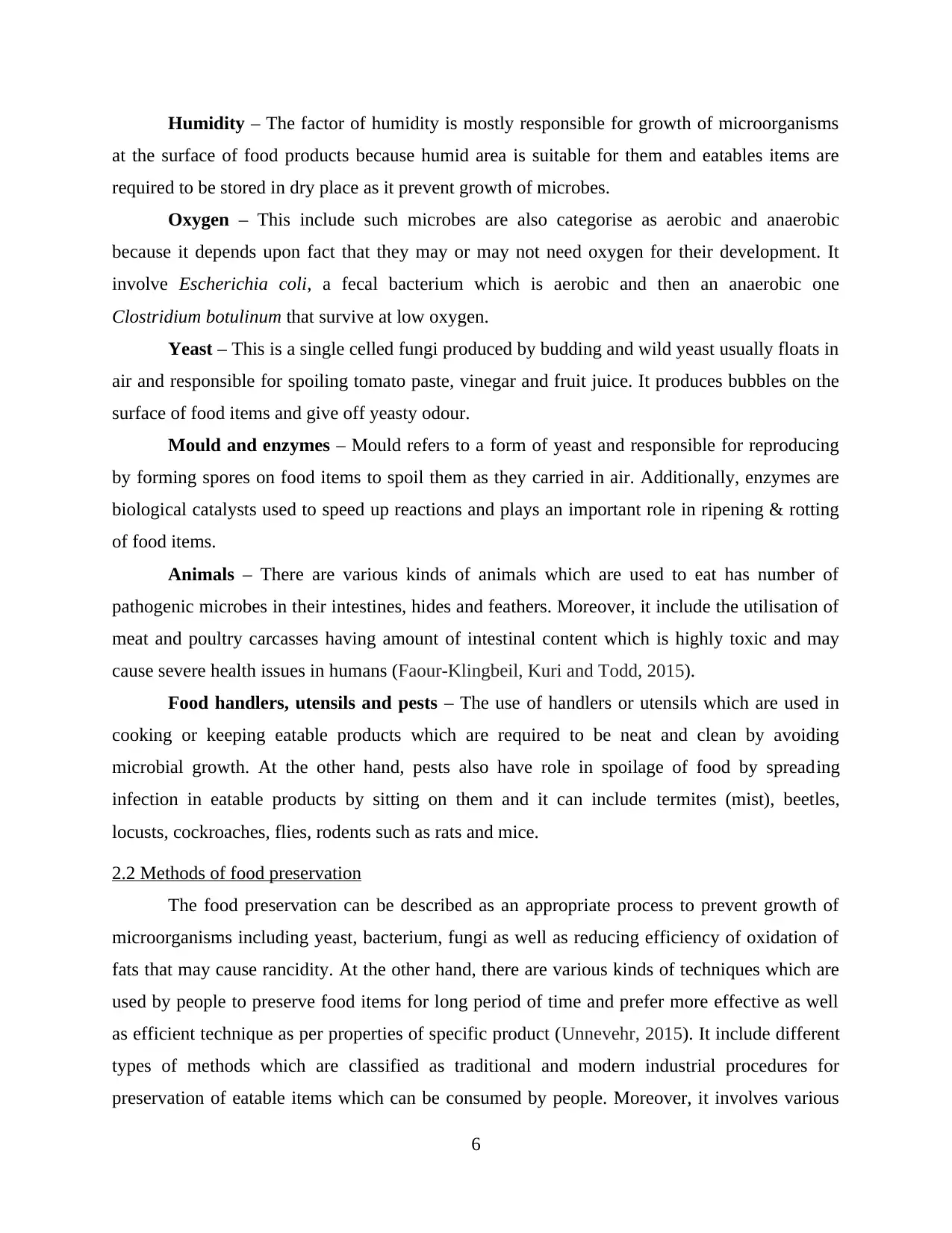
Humidity – The factor of humidity is mostly responsible for growth of microorganisms
at the surface of food products because humid area is suitable for them and eatables items are
required to be stored in dry place as it prevent growth of microbes.
Oxygen – This include such microbes are also categorise as aerobic and anaerobic
because it depends upon fact that they may or may not need oxygen for their development. It
involve Escherichia coli, a fecal bacterium which is aerobic and then an anaerobic one
Clostridium botulinum that survive at low oxygen.
Yeast – This is a single celled fungi produced by budding and wild yeast usually floats in
air and responsible for spoiling tomato paste, vinegar and fruit juice. It produces bubbles on the
surface of food items and give off yeasty odour.
Mould and enzymes – Mould refers to a form of yeast and responsible for reproducing
by forming spores on food items to spoil them as they carried in air. Additionally, enzymes are
biological catalysts used to speed up reactions and plays an important role in ripening & rotting
of food items.
Animals – There are various kinds of animals which are used to eat has number of
pathogenic microbes in their intestines, hides and feathers. Moreover, it include the utilisation of
meat and poultry carcasses having amount of intestinal content which is highly toxic and may
cause severe health issues in humans (Faour-Klingbeil, Kuri and Todd, 2015).
Food handlers, utensils and pests – The use of handlers or utensils which are used in
cooking or keeping eatable products which are required to be neat and clean by avoiding
microbial growth. At the other hand, pests also have role in spoilage of food by spreading
infection in eatable products by sitting on them and it can include termites (mist), beetles,
locusts, cockroaches, flies, rodents such as rats and mice.
2.2 Methods of food preservation
The food preservation can be described as an appropriate process to prevent growth of
microorganisms including yeast, bacterium, fungi as well as reducing efficiency of oxidation of
fats that may cause rancidity. At the other hand, there are various kinds of techniques which are
used by people to preserve food items for long period of time and prefer more effective as well
as efficient technique as per properties of specific product (Unnevehr, 2015). It include different
types of methods which are classified as traditional and modern industrial procedures for
preservation of eatable items which can be consumed by people. Moreover, it involves various
6
at the surface of food products because humid area is suitable for them and eatables items are
required to be stored in dry place as it prevent growth of microbes.
Oxygen – This include such microbes are also categorise as aerobic and anaerobic
because it depends upon fact that they may or may not need oxygen for their development. It
involve Escherichia coli, a fecal bacterium which is aerobic and then an anaerobic one
Clostridium botulinum that survive at low oxygen.
Yeast – This is a single celled fungi produced by budding and wild yeast usually floats in
air and responsible for spoiling tomato paste, vinegar and fruit juice. It produces bubbles on the
surface of food items and give off yeasty odour.
Mould and enzymes – Mould refers to a form of yeast and responsible for reproducing
by forming spores on food items to spoil them as they carried in air. Additionally, enzymes are
biological catalysts used to speed up reactions and plays an important role in ripening & rotting
of food items.
Animals – There are various kinds of animals which are used to eat has number of
pathogenic microbes in their intestines, hides and feathers. Moreover, it include the utilisation of
meat and poultry carcasses having amount of intestinal content which is highly toxic and may
cause severe health issues in humans (Faour-Klingbeil, Kuri and Todd, 2015).
Food handlers, utensils and pests – The use of handlers or utensils which are used in
cooking or keeping eatable products which are required to be neat and clean by avoiding
microbial growth. At the other hand, pests also have role in spoilage of food by spreading
infection in eatable products by sitting on them and it can include termites (mist), beetles,
locusts, cockroaches, flies, rodents such as rats and mice.
2.2 Methods of food preservation
The food preservation can be described as an appropriate process to prevent growth of
microorganisms including yeast, bacterium, fungi as well as reducing efficiency of oxidation of
fats that may cause rancidity. At the other hand, there are various kinds of techniques which are
used by people to preserve food items for long period of time and prefer more effective as well
as efficient technique as per properties of specific product (Unnevehr, 2015). It include different
types of methods which are classified as traditional and modern industrial procedures for
preservation of eatable items which can be consumed by people. Moreover, it involves various
6
⊘ This is a preview!⊘
Do you want full access?
Subscribe today to unlock all pages.

Trusted by 1+ million students worldwide
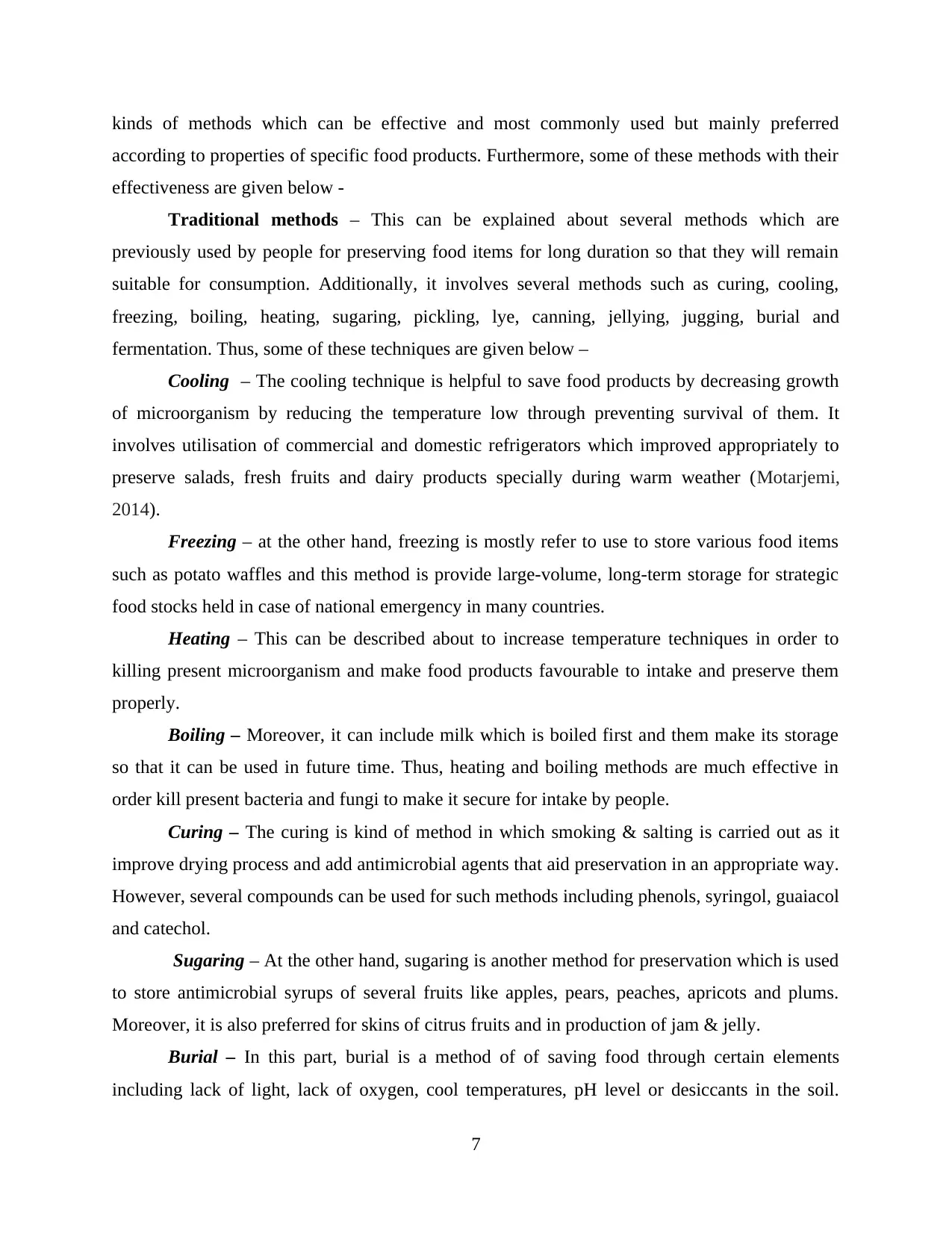
kinds of methods which can be effective and most commonly used but mainly preferred
according to properties of specific food products. Furthermore, some of these methods with their
effectiveness are given below -
Traditional methods – This can be explained about several methods which are
previously used by people for preserving food items for long duration so that they will remain
suitable for consumption. Additionally, it involves several methods such as curing, cooling,
freezing, boiling, heating, sugaring, pickling, lye, canning, jellying, jugging, burial and
fermentation. Thus, some of these techniques are given below –
Cooling – The cooling technique is helpful to save food products by decreasing growth
of microorganism by reducing the temperature low through preventing survival of them. It
involves utilisation of commercial and domestic refrigerators which improved appropriately to
preserve salads, fresh fruits and dairy products specially during warm weather (Motarjemi,
2014).
Freezing – at the other hand, freezing is mostly refer to use to store various food items
such as potato waffles and this method is provide large-volume, long-term storage for strategic
food stocks held in case of national emergency in many countries.
Heating – This can be described about to increase temperature techniques in order to
killing present microorganism and make food products favourable to intake and preserve them
properly.
Boiling – Moreover, it can include milk which is boiled first and them make its storage
so that it can be used in future time. Thus, heating and boiling methods are much effective in
order kill present bacteria and fungi to make it secure for intake by people.
Curing – The curing is kind of method in which smoking & salting is carried out as it
improve drying process and add antimicrobial agents that aid preservation in an appropriate way.
However, several compounds can be used for such methods including phenols, syringol, guaiacol
and catechol.
Sugaring – At the other hand, sugaring is another method for preservation which is used
to store antimicrobial syrups of several fruits like apples, pears, peaches, apricots and plums.
Moreover, it is also preferred for skins of citrus fruits and in production of jam & jelly.
Burial – In this part, burial is a method of of saving food through certain elements
including lack of light, lack of oxygen, cool temperatures, pH level or desiccants in the soil.
7
according to properties of specific food products. Furthermore, some of these methods with their
effectiveness are given below -
Traditional methods – This can be explained about several methods which are
previously used by people for preserving food items for long duration so that they will remain
suitable for consumption. Additionally, it involves several methods such as curing, cooling,
freezing, boiling, heating, sugaring, pickling, lye, canning, jellying, jugging, burial and
fermentation. Thus, some of these techniques are given below –
Cooling – The cooling technique is helpful to save food products by decreasing growth
of microorganism by reducing the temperature low through preventing survival of them. It
involves utilisation of commercial and domestic refrigerators which improved appropriately to
preserve salads, fresh fruits and dairy products specially during warm weather (Motarjemi,
2014).
Freezing – at the other hand, freezing is mostly refer to use to store various food items
such as potato waffles and this method is provide large-volume, long-term storage for strategic
food stocks held in case of national emergency in many countries.
Heating – This can be described about to increase temperature techniques in order to
killing present microorganism and make food products favourable to intake and preserve them
properly.
Boiling – Moreover, it can include milk which is boiled first and them make its storage
so that it can be used in future time. Thus, heating and boiling methods are much effective in
order kill present bacteria and fungi to make it secure for intake by people.
Curing – The curing is kind of method in which smoking & salting is carried out as it
improve drying process and add antimicrobial agents that aid preservation in an appropriate way.
However, several compounds can be used for such methods including phenols, syringol, guaiacol
and catechol.
Sugaring – At the other hand, sugaring is another method for preservation which is used
to store antimicrobial syrups of several fruits like apples, pears, peaches, apricots and plums.
Moreover, it is also preferred for skins of citrus fruits and in production of jam & jelly.
Burial – In this part, burial is a method of of saving food through certain elements
including lack of light, lack of oxygen, cool temperatures, pH level or desiccants in the soil.
7
Paraphrase This Document
Need a fresh take? Get an instant paraphrase of this document with our AI Paraphraser
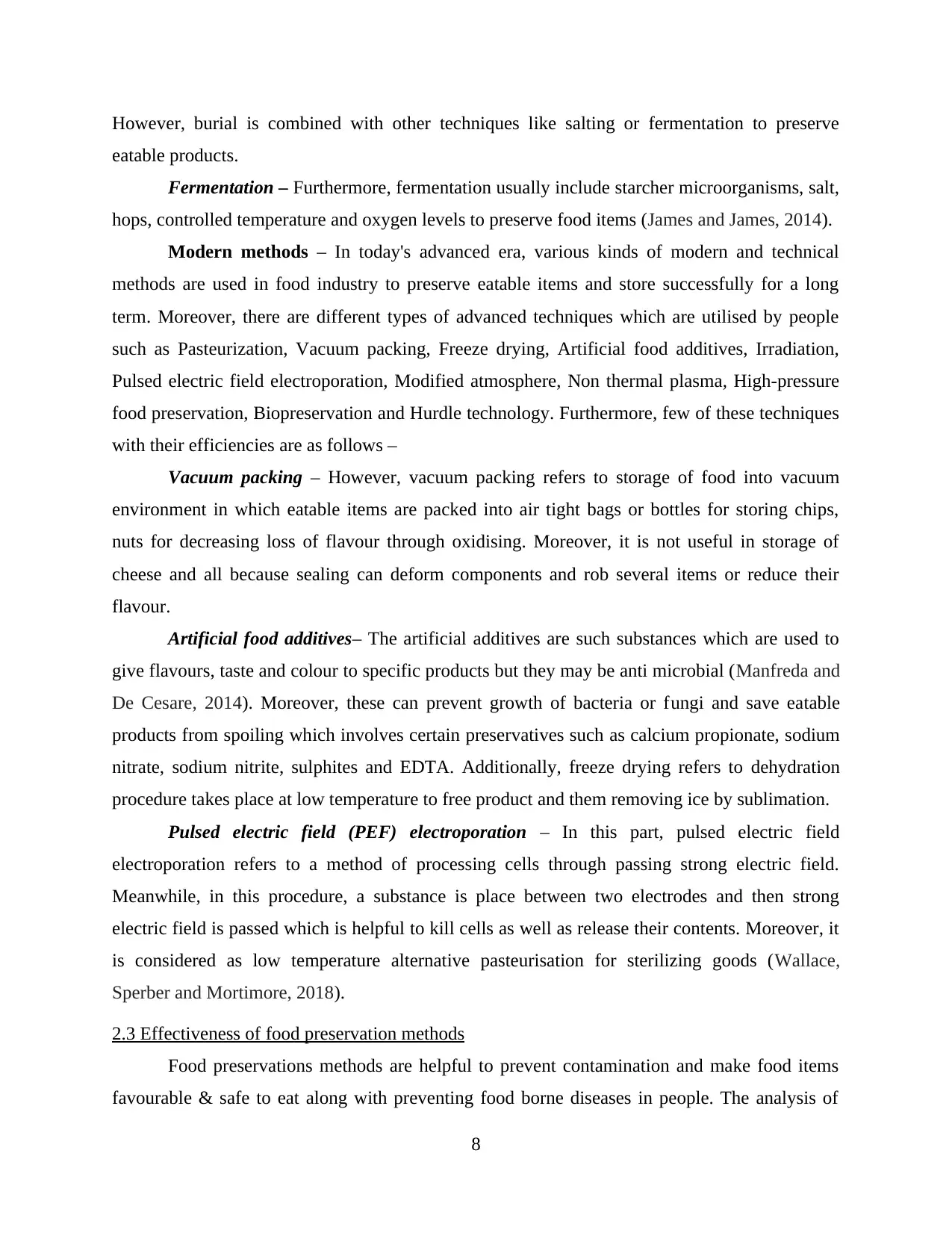
However, burial is combined with other techniques like salting or fermentation to preserve
eatable products.
Fermentation – Furthermore, fermentation usually include starcher microorganisms, salt,
hops, controlled temperature and oxygen levels to preserve food items (James and James, 2014).
Modern methods – In today's advanced era, various kinds of modern and technical
methods are used in food industry to preserve eatable items and store successfully for a long
term. Moreover, there are different types of advanced techniques which are utilised by people
such as Pasteurization, Vacuum packing, Freeze drying, Artificial food additives, Irradiation,
Pulsed electric field electroporation, Modified atmosphere, Non thermal plasma, High-pressure
food preservation, Biopreservation and Hurdle technology. Furthermore, few of these techniques
with their efficiencies are as follows –
Vacuum packing – However, vacuum packing refers to storage of food into vacuum
environment in which eatable items are packed into air tight bags or bottles for storing chips,
nuts for decreasing loss of flavour through oxidising. Moreover, it is not useful in storage of
cheese and all because sealing can deform components and rob several items or reduce their
flavour.
Artificial food additives– The artificial additives are such substances which are used to
give flavours, taste and colour to specific products but they may be anti microbial (Manfreda and
De Cesare, 2014). Moreover, these can prevent growth of bacteria or fungi and save eatable
products from spoiling which involves certain preservatives such as calcium propionate, sodium
nitrate, sodium nitrite, sulphites and EDTA. Additionally, freeze drying refers to dehydration
procedure takes place at low temperature to free product and them removing ice by sublimation.
Pulsed electric field (PEF) electroporation – In this part, pulsed electric field
electroporation refers to a method of processing cells through passing strong electric field.
Meanwhile, in this procedure, a substance is place between two electrodes and then strong
electric field is passed which is helpful to kill cells as well as release their contents. Moreover, it
is considered as low temperature alternative pasteurisation for sterilizing goods (Wallace,
Sperber and Mortimore, 2018).
2.3 Effectiveness of food preservation methods
Food preservations methods are helpful to prevent contamination and make food items
favourable & safe to eat along with preventing food borne diseases in people. The analysis of
8
eatable products.
Fermentation – Furthermore, fermentation usually include starcher microorganisms, salt,
hops, controlled temperature and oxygen levels to preserve food items (James and James, 2014).
Modern methods – In today's advanced era, various kinds of modern and technical
methods are used in food industry to preserve eatable items and store successfully for a long
term. Moreover, there are different types of advanced techniques which are utilised by people
such as Pasteurization, Vacuum packing, Freeze drying, Artificial food additives, Irradiation,
Pulsed electric field electroporation, Modified atmosphere, Non thermal plasma, High-pressure
food preservation, Biopreservation and Hurdle technology. Furthermore, few of these techniques
with their efficiencies are as follows –
Vacuum packing – However, vacuum packing refers to storage of food into vacuum
environment in which eatable items are packed into air tight bags or bottles for storing chips,
nuts for decreasing loss of flavour through oxidising. Moreover, it is not useful in storage of
cheese and all because sealing can deform components and rob several items or reduce their
flavour.
Artificial food additives– The artificial additives are such substances which are used to
give flavours, taste and colour to specific products but they may be anti microbial (Manfreda and
De Cesare, 2014). Moreover, these can prevent growth of bacteria or fungi and save eatable
products from spoiling which involves certain preservatives such as calcium propionate, sodium
nitrate, sodium nitrite, sulphites and EDTA. Additionally, freeze drying refers to dehydration
procedure takes place at low temperature to free product and them removing ice by sublimation.
Pulsed electric field (PEF) electroporation – In this part, pulsed electric field
electroporation refers to a method of processing cells through passing strong electric field.
Meanwhile, in this procedure, a substance is place between two electrodes and then strong
electric field is passed which is helpful to kill cells as well as release their contents. Moreover, it
is considered as low temperature alternative pasteurisation for sterilizing goods (Wallace,
Sperber and Mortimore, 2018).
2.3 Effectiveness of food preservation methods
Food preservations methods are helpful to prevent contamination and make food items
favourable & safe to eat along with preventing food borne diseases in people. The analysis of
8
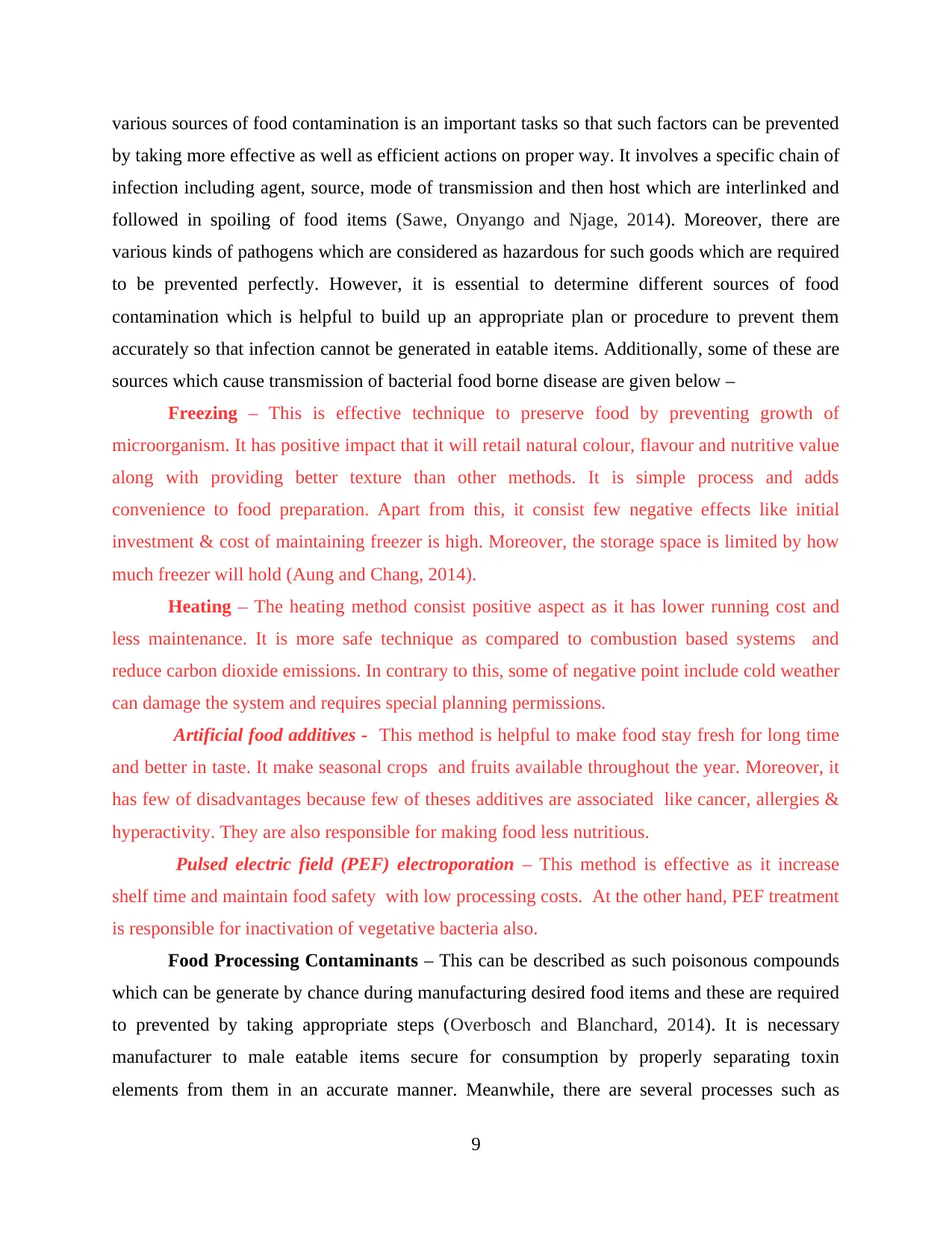
various sources of food contamination is an important tasks so that such factors can be prevented
by taking more effective as well as efficient actions on proper way. It involves a specific chain of
infection including agent, source, mode of transmission and then host which are interlinked and
followed in spoiling of food items (Sawe, Onyango and Njage, 2014). Moreover, there are
various kinds of pathogens which are considered as hazardous for such goods which are required
to be prevented perfectly. However, it is essential to determine different sources of food
contamination which is helpful to build up an appropriate plan or procedure to prevent them
accurately so that infection cannot be generated in eatable items. Additionally, some of these are
sources which cause transmission of bacterial food borne disease are given below –
Freezing – This is effective technique to preserve food by preventing growth of
microorganism. It has positive impact that it will retail natural colour, flavour and nutritive value
along with providing better texture than other methods. It is simple process and adds
convenience to food preparation. Apart from this, it consist few negative effects like initial
investment & cost of maintaining freezer is high. Moreover, the storage space is limited by how
much freezer will hold (Aung and Chang, 2014).
Heating – The heating method consist positive aspect as it has lower running cost and
less maintenance. It is more safe technique as compared to combustion based systems and
reduce carbon dioxide emissions. In contrary to this, some of negative point include cold weather
can damage the system and requires special planning permissions.
Artificial food additives - This method is helpful to make food stay fresh for long time
and better in taste. It make seasonal crops and fruits available throughout the year. Moreover, it
has few of disadvantages because few of theses additives are associated like cancer, allergies &
hyperactivity. They are also responsible for making food less nutritious.
Pulsed electric field (PEF) electroporation – This method is effective as it increase
shelf time and maintain food safety with low processing costs. At the other hand, PEF treatment
is responsible for inactivation of vegetative bacteria also.
Food Processing Contaminants – This can be described as such poisonous compounds
which can be generate by chance during manufacturing desired food items and these are required
to prevented by taking appropriate steps (Overbosch and Blanchard, 2014). It is necessary
manufacturer to male eatable items secure for consumption by properly separating toxin
elements from them in an accurate manner. Meanwhile, there are several processes such as
9
by taking more effective as well as efficient actions on proper way. It involves a specific chain of
infection including agent, source, mode of transmission and then host which are interlinked and
followed in spoiling of food items (Sawe, Onyango and Njage, 2014). Moreover, there are
various kinds of pathogens which are considered as hazardous for such goods which are required
to be prevented perfectly. However, it is essential to determine different sources of food
contamination which is helpful to build up an appropriate plan or procedure to prevent them
accurately so that infection cannot be generated in eatable items. Additionally, some of these are
sources which cause transmission of bacterial food borne disease are given below –
Freezing – This is effective technique to preserve food by preventing growth of
microorganism. It has positive impact that it will retail natural colour, flavour and nutritive value
along with providing better texture than other methods. It is simple process and adds
convenience to food preparation. Apart from this, it consist few negative effects like initial
investment & cost of maintaining freezer is high. Moreover, the storage space is limited by how
much freezer will hold (Aung and Chang, 2014).
Heating – The heating method consist positive aspect as it has lower running cost and
less maintenance. It is more safe technique as compared to combustion based systems and
reduce carbon dioxide emissions. In contrary to this, some of negative point include cold weather
can damage the system and requires special planning permissions.
Artificial food additives - This method is helpful to make food stay fresh for long time
and better in taste. It make seasonal crops and fruits available throughout the year. Moreover, it
has few of disadvantages because few of theses additives are associated like cancer, allergies &
hyperactivity. They are also responsible for making food less nutritious.
Pulsed electric field (PEF) electroporation – This method is effective as it increase
shelf time and maintain food safety with low processing costs. At the other hand, PEF treatment
is responsible for inactivation of vegetative bacteria also.
Food Processing Contaminants – This can be described as such poisonous compounds
which can be generate by chance during manufacturing desired food items and these are required
to prevented by taking appropriate steps (Overbosch and Blanchard, 2014). It is necessary
manufacturer to male eatable items secure for consumption by properly separating toxin
elements from them in an accurate manner. Meanwhile, there are several processes such as
9
⊘ This is a preview!⊘
Do you want full access?
Subscribe today to unlock all pages.

Trusted by 1+ million students worldwide
1 out of 20
Related Documents
Your All-in-One AI-Powered Toolkit for Academic Success.
+13062052269
info@desklib.com
Available 24*7 on WhatsApp / Email
![[object Object]](/_next/static/media/star-bottom.7253800d.svg)
Unlock your academic potential
Copyright © 2020–2025 A2Z Services. All Rights Reserved. Developed and managed by ZUCOL.





